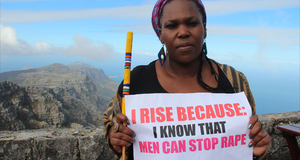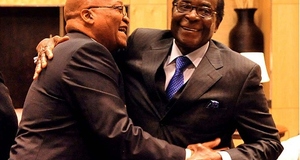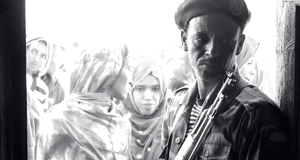Featured Article:Identity in Conflict: Race and Violent Crime in South Africa in the Context of Contemporary InsurgenciesClass and RaceClass is part-and-parcel of identity, and in contemporary insurgencies this often leads to previously excluded layers of the population venting their anger on others considered more affluent (Münkler, 2005: 78-81). Violence is seen as a way of obtaining social recognition, either through combating the influx of consumerism (in the case of radical Islam), or by providing rapid access to the symbols of Western affluence in terms of clothing, sunglasses, motor vehicles etc. (Münkler, 2005: 78) – particularly in Africa. Violence becomes one of the few available avenues for escaping poverty, as argued by Metz (2008: 35), “Without a gun, most insurgent soldiers are simply poor, uneducated, disempowered people with no prospects and little hope. Insurgency changes all that. It makes the insurgent important and powerful and provides a livelihood.” Neo-liberal policies adopted globally have contributed to this problem, as it generally involved an increase in the level of unemployment, rapid urbanization, and increased migration and urbanization (Kaldor, 2006: 87), while at the same time the globalised culture industry has created desires for status symbols, which are unobtainable by the poor. Similarly, in Ross & Mirowsky’s (1987: 258) view, crime is precisely the acceptance of financial prosperity as goal, but the inability to achieve that prosperity through legal means (because of structural issues that render the individual powerless to escape the poverty quagmire) forces particularly the poor to reject legal and moral codes of conduct. One result in poor communities is a zero-sum outlook, as summarized by Ross, Mirowsky and Pribesh (2001: 570), “The zero-sum world view regards the total amount of wealth, power, or prestige as limited, so that one person’s gain implies another person’s loss. People with few resources compete for a limited pool of resources. People with power and wealth presumably reached that position by exploiting others.” Shapiro (2009: 447) sees the modern city as “a site of class and ethnic warfare” where the rich build walls to shield themselves from the poor (see also Barolsky and Pillay (2009: 16)). South African cities have become enclosed spaces with walls around estates, town house complexes and individual houses – often accompanied by an electrified fence. This spatial segregation contributes to social exclusion and reduced contact between different races and classes (Landman and Schönteich, 2002: 81), which Valji, Harris and Simpson (2004) call “the visible face of exclusion; a barrier between the haves and the have-nots.” From one side of the fence resentment festers; from the other mistrust.iiiRoss, Mirowsky and Pribesh (2001: 570) have found that mistrust contributes significantly to social isolation, because people who trust others tend to form more voluntary relationships, and mistrust itself is partially the result of living in an environment where it is difficult to distinguish between real and perceived threats. Since the price paid for unwarranted mistrust is much lower than the price of unwarranted trust, mistrusting others becomes the safer approach. This results in what the authors (2001: 584) call a “self-amplifying downward spiral” that deepens social alienation from the side of the wealthy, but if the poor resent the wealthy through the application of a zero-sum outlook, alienation between classes deepens even further. Barolsky and Pillay (2009: 18) come to a comparable understanding of violent crime in South Africa, “We see the impact of violent crime in creating forms of community that are at odds with unifying nation-building efforts of governments. The result is balkanized zones of governance and citizenship in the global South: in informal settlements, gated communities, vigilante groups and gangs.” In South Africa, race and class cannot be considered separately, because whites remain, on average, financially better off than blacks. Hamel, Brodie and Morin (2005: 353) write that after a decade of democracy, “South Africa remains a country of ‘Haves’ (mainly Whites) and ‘Have-nots’ (mainly Blacks)” (see also CSVR 2007: 31). However, race and class are not interchangeable terms in South Africa, nor were they ever. Apartheid itself had developed out of a need to address the problem of poverty among whites, and Schuermans and Visser (2005: 288) note how structural reforms in the late 1970s and the 1980s influenced the current situation, where a much higher growth of white poverty in comparison with the national average has been observed. The ANC and sections of the media however routinely allege that the white community as a whole is “rich,” and “Such simplistic reasoning is easily digested by those bitter or frustrated at their poverty, with hateful attitudes re-emerging as dangerous stereotyping accepted as objective truth” (Warwick, 2009). Mandela argued for the construction of an inclusive South African identity, “We refuse to accept that our Africanness shall be defined by our race, color, gender or historical origins. It is a firm assertion made by ourselves that South Africa belongs to all who live in it, black and white” (quoted in Hermann 2009). In line with Kaldor’s (2006: 85) abovementioned observation that ethnicity is reinvented in light of post-independence disillusionment, Mbeki’s presidency however reinvented racial discourse within the context of economic failure and violent crime, and Mbeki himself described South African society as composed of two populations: One rich and white, the other poor and black (Hermann, 2009). The so-called ‘class war’ mentioned above thereby becomes reconstructed as a ‘race war’ that feeds on absolutist identity constructions of the past – identity politics often reinvented for political goals. Andile Mngxitama (2010) of the Foundation for Human Rights, writing an opinion piece on the Mail & Guardian Online, for instance rejects Mandela’s conception of South African identity by claiming that the radio DJ Gareth Cliff’s letter to the government, “uses the universal ‘we’ to erase the differential realities of blacks and whites and thereby presents his white perspective as representing all.” Mngxitama uses “oppressed” as a synonym for “black” and “privileged” as a synonym for “white,” and in a decisively zero-sum outlook, he claims, “When Cliff complains about corruption and how it affects the rich (read whites), he never pauses to ask how the rich got rich in the first place. If he asked this he would have to confront a bitter reality that whites accumulated wealth and comfort not through hard work but violence, plunder and theft.” As is the case with the numerous internet discussions on the Reitz-video incident, subsequent comments show that these types of views are neither widely shared nor isolated, although verifying the existence of commentators on the internet is notoriously difficult. Nevertheless, these views are expressed in the public domain. Nowhere was this zero-sum outlook and reductionist class/race view voiced more clearly than in the widely reported call by the leader of the Uhuru Cultural Club, Faraday Nkoane, in 2006: “The whites have stolen from us since April 6, 1652. Our ancestors’ cattle, goats, sheep, chickens and others are in the hands of the whites, while we are left with nothing. Go and steal from them because it is right. Taking from whites is not a crime because you repossess what belongs to you.” While such views are extreme and not representative of the black population in general, racial relations deteriorated under Mbeki’s presidency. Gibson & Claasen’s (2009) study found that black South Africans not only score higher for racial prejudice towards whites than vice versa, but their study also shows an increase in racial prejudice for the black population between 2001 and 2004, whereas a decrease was noted for Indian and white minorities. They (2009: 11) write, “we observe significant differences across time for all race groups: a clear decrease in reconciliation for Africans, and increases for the other groups.” Gibson & Claasen’s assessment of white attitudes is underscored by the view of the South African Institute of Race Relations, “much white opinion since the early 1990s has been moderate. White South Africa has been willing and often eager to cooperate with the Government in building an open, non-racial, and prosperous South Africa” (PRAAG, 2010). While whites have, apart from highly publicized exceptions like the Reitz video, thus generally attempted to incorporate the ideal of the new democracy, racial identities are again imposed on whites as they were during the apartheid years. The present utilization of identity politics in turn reconstructs an Afrikaner laager mentality that played a major role in the construction and maintenance of apartheid in the first place: By 2003, Afrikaners numbered a mere 3.2 million, and this numerical disadvantage has been “the primary cause of fears regarding security and cultural survival” (Giliomee, 2004: xvi). The result is what Valji, Harris and Simpson (2004) refer to as a “fear of crime fuelled by the mythology that whites are the primary targets merely because of their race.” This perception is voiced by Warwick (2009) as well, “the de facto situation is that whites are under criminal siege explicitly because of their ‘race’. Despite evasion in acknowledging this, enough media reports confirm a shockingly high degree of anti-white violence accompanied by racial insults.” Unfortunately, the SAPS does not keep statistics on racial demographics in crime, and thus it is difficult to verify, quantify or contradict this view with certainty. The Centre for the Study of Violence and Reconciliation note “reasonable evidence that there are substantial differences in levels of risk of violent victimization and offending between different race groups in South Africa” (CSVR, 2007: 131), although lamenting the difficulty of finding accurate up-to-date information. For instance, they cite data by the National Injury Mortality Surveillance System, collected from 32 mortuaries in 2001, which indicates that among deaths at those mortuaries, “51% of Colored deaths, 48% of African deaths, 27% of Asian deaths and 18% of White deaths were linked to homicide” (CSVR, 2007: 132). They offer a careful explanation of these and other statistics, This probably indicates that, of homicides among Coloureds, Africans and Indians, a high proportion is related to arguments and acquaintance violence. A higher proportion of homicides among Whites is probably related to robberies and perhaps burglaries of people in the 35–54 age band. These are probably people who have established careers and who therefore present more attractive targets for property crime. However, this does not necessarily mean that Whites suffer more than other groups from murders related to predatory crime. The higher overall rate of murder of members of other race groups may also include a substantial proportion of murders related to predatory crime.iv In 2004, The Washington Post, the Kaiser Family Foundation, and Harvard University conducted a nationally representative survey of South Africans, “in order to shed light on South Africans’ attitudes towards and experiences with democracy, their level of trust in leaders and institutions, and their hopes and fears for the future of South Africa” (Hamel, Brodie and Morin, 2005: 351). In such a representative survey, it is noteworthy that although a third of South Africans reported that they had been the victim of crime in the previous five years, the survey did not reflect a general consistency across races: A majority of Whites (62%) and Indians (51%), and a smaller share of Coloreds (35%) and Blacks (28%) reported having been victims of crime (2005: 353). Correlated with this uneven distribution, whites and Indians were found to be more pessimistic and have less confidence in government than coloreds or blacks (2005: 354), and the authors conclude that crime has a direct impact on these attitudes, “After controlling for other factors, those who have been a victim of crime or know someone close to them who has been a victim are more likely to say things have gotten worse since apartheid, and have lower confidence in government than those who have no experience with crime” (2005: 361). Whites can also come to see the black population as a whole as criminals, and thus also contribute to the perpetuation of stereotypes. Schuermans and Visser (2005: 288) acknowledge that “’whiteness’ is still associated with normal, comfortable lives, both by those whites who find themselves to be poor and those who are not poor.” If not being poor has become part of white identity, being black suggests the possibility of being poor, and since the poor come to be viewed as the threat (Shapiro, 2009: 447), the swart gevaar (black menace) can manifest in a new, post-apartheid guise. Valji, Harris and Simpson (2004) note how “'the hijacker' frequently means 'the young, black, male criminal' in white suburbia.” By seeing class as synonymous with race, South African society continues to be divided along racial lines. The zero-sum outlook – of which the abovementioned provides evidence – risks demonizing whites in post-apartheid South Africa, for if “People with power and wealth presumably reached that position by exploiting others,” (Ross, Mirowsky and Pribesh, 2001: 570), and whites are perceived to be the demographic with wealth and power, attacks on whites can become justified. Furthermore, as whites continue to feel threatened in the new South Africa, the trend observed by Gibson & Claassen may well be reversed and spark a new increase in white racism.Continued on Next Page » Suggested Reading from Inquiries Journal
Inquiries Journal provides undergraduate and graduate students around the world a platform for the wide dissemination of academic work over a range of core disciplines. Representing the work of students from hundreds of institutions around the globe, Inquiries Journal's large database of academic articles is completely free. Learn more | Blog | Submit Latest in Political Science |


















